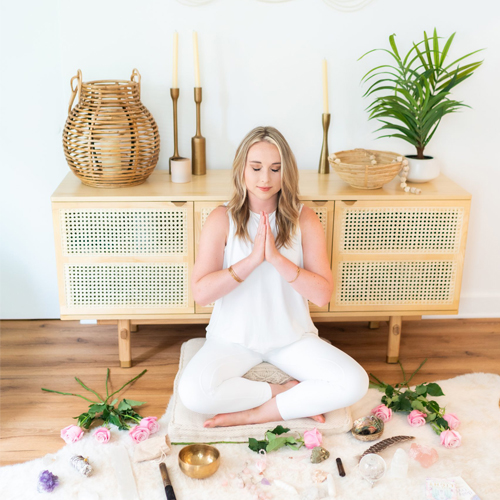Chakras were first mentioned in the Vedas, ancient Hindu texts, and since then it has been recognized in many different cultures that we have life force energy, or prana, moving inside us, providing energy to different parts of our body, mind, and spirit. The Sanskrit word “chakra” means “wheel” or “disk.” Chakras are energy wheels, or energy centers, in the body that run from the base of the spine up to the crown of the head. The chakras are shaped like cylinders and act as channels for energy to flow throughout our bodies so we can maintain balance.
There are 7 main energy wheels – the root chakra, sacral chakra, solar plexus chakra, heart chakra, throat chakra, third eye chakra, and crown chakra. Chakras can be out of balance in a number of ways – they can be blocked, too open, or even in the wrong shape. Each chakra is related to a different color and corresponds to a physical, emotional, mental, and spiritual state.
A healthy, balanced person will have all of his or her chakras balanced individually, and all of them will also be in balance with each other. If one of your chakras is out of balance, this could manifest physiologically as a health issue related to that chakra’s corresponding body part, which is why it’s so important to we keep our chakras balanced. The opposite is also true – a physiological ailment could cause the corresponding chakra to become out of balance. This connection is how imbalances related to our emotions or lifestyles can manifest themselves physiologically in our bodies. For example, someone who never speaks their truth might experience problems with their thyroid, or someone with a lack of self-confidence or autonomy might experience digestive issues (more on this in a bit). When our chakras are open and in balance, our energy is flowing freely and we reach an optimal state of physical, emotional, and spiritual health because we have exactly the right amount of energy going to each part of our body, mind, and spirit.
You can balance your chakras through Reiki, other forms of energy healing, your diet, meditation, visualization, yoga, crystals, essential oils, adding certain colors to your life, or making personal or spiritual changes to support the imbalanced chakra.
In order to know how to balance your chakras, it’s important to understand what each chakra means! An energy healer can tell you which of your chakras is out of balance, but you might be able to guess for yourself just by understanding what each chakra is associated with.
The Seven Chakras
The first chakra is your root chakra, which is located at the base of your spine. The root chakra is related to the color red, and this chakra has to do with the adrenals, skin, blood, large intestine, pelvis, hips, legs, feet, and elimination system in general. The root chakra deals with a sense of grounding, stability, and security. This chakra can be related to survival, trust, money, home, nature, earth, or your sense of belonging. It is often related to feeling”grounded” when it comes to your career, relationships, finances, or where you’re living. This is often out of balance for people who travel or move often, who are in-between jobs or unhappy with their career, who don’t feel stable in their relationship, who worry about money, or who don’t feel physically or emotionally “rooted.”
The second chakra is your sacral chakra, which is located in the abdomen or navel area. The sacral chakra is associated with the color orange, and this chakra deals with the reproductive system. This chakra is connected with the testes, ovaries, uterus, lower digestive organs, kidneys, prostate, urinary tract, and lower back. The sacral chakra mainly has to do with sexuality, relationships, emotions, intimacy, sensations, and pleasure. It’s also related to appetite, imagination, and the unconscious. I think of the sacral chakra as the “passion” chakra. It most often has to do with romance and sexuality, but sometimes it’s pointing toward pleasure and passion in other areas of a person’s life, such as passion for a creative project. This chakra also often relates to a person’s sense of femininity and / or masculinity.
The third chakra is the solar plexus, which is located below the sternum. The solar plexus is associated with the color yellow, and this chakra is related to the digestive system. This chakra deals with the pancreas, liver, spleen, small intestine, gallbladder, and middle back. The solar plexus is almost always out of balance for people with digestive issues. This chakra also has to do with personal power, self-esteem, self-empowerment, autonomy, self-determination, and a sense of purpose.
The fourth chakra is the heart chakra, which is located in the center of the chest. The heart chakra is associated with the color green, and it’s connected to the heart, thymus, respiration, circulation, immune system, lungs, upper back, hands, and arms. The heart chakra is related to compassion, kindness, unconditional love, balance, and giving. This might have to do with the person’s own ability to give love and compassion to others, or it could have to do with whether others offer love, compassion, and kindness to that person.
The fifth chakra is the throat chakra, which is located around your throat. The throat chakra is related to the color blue, and it’s connected with the thyroid, parathyroid, metabolism, ears, nose, mouth, neck, throat, and teeth. This chakra is related to communication, self-expression, sound, receiving, and creativity. This chakra is usually out of balance for people who haven’t spoken their truth in some way. When the throat chakra is out of balance, it usually means the person needs to tell someone something or speak out about something, or it could mean something is being kept from them. At its core, this chakra is about self-expression (which isn’t always verbal) and communication.
The sixth chakra is the third eye chakra, which is located between the eyebrows. The third eye chakra is connected with the color indigo, and it’s related to the brain, pituitary, hypothalamus, endocrine system, head, eyes, and face. The third eye chakra is associated with intuition, spiritual awareness, clairvoyance, imagination, and individual consciousness. When this chakra is out of balance, it’s usually an indication that the person needs to focus on getting in touch with their spirituality.
The seventh chakra is the crown chakra, which is located at the top of the head. The crown chakra is related to the color white or violet, and it has to do with the nervous system, pineal gland, mind, and whole body. The crown chakra is related to enlightenment, spirituality, connection, fulfillment, completion, and universal consciousness. If you can only balance one chakra, make it the crown chakra! Many people confuse the crown chakra and the third eye chakra, and while they have some similarities, they are different. The third eye is really more related to spirituality and intuition, while the crown chakra has to do more with the person’s connection to the larger universe, sense of fulfillment within their being, and greater sense of purpose.
Once you understand what the chakras mean and know which of yours are out of balance, you can rebalance them and make the appropriate adjustments in your life to maintain that balance. Reiki, yoga, and meditation can help balance your chakras, as can incorporating more of the chakra’s associated color into your life, and of course focusing on working through the underlying emotions connected to that chakra. For example, if you never speak your truth or get “that thing” off your chest that you’ve been wanting to say, your throat chakra will probably keep going out of balance. I recommend incorporating multiple modalities of chakra balancing for best results!
Have you noticed that any of your chakras in particular are often out of balance? Share below!






Get Updates
And Goodies
We’re over fake “wellness.” It’s time to unlock your magic & magnetism. Are you ready to vibe higher?
Are you ready to finally optimize your health habits for real results and true health?